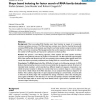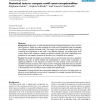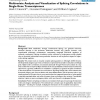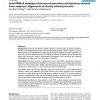2060 search results - page 410 / 412 » The Composition of Event-B Models |
BMCBI
2008
13 years 11 months ago
2008
Background: Most non-coding RNA families exert their function by means of a conserved, common secondary structure. The Rfam data base contains more than five hundred structurally ...
BMCBI
2007
13 years 11 months ago
2007
Background: By virtue of their shared ancestry, homologous sequences are similar in their structure and function. Consequently, multiple sequence alignments are routinely used to ...
BMCBI
2007
13 years 11 months ago
2007
Background: Finding over- or under-represented motifs in biological sequences is now a common task in genomics. Thanks to p-value calculation for motif counts, exceptional motifs ...
BMCBI
2007
13 years 11 months ago
2007
Background: RNA metabolism, through 'combinatorial splicing', can generate enormous structural diversity in the proteome. Alternative domains may interact, however, with...
BMCBI
2008
13 years 11 months ago
2008
Background: Insertions and deletions (indels) represent a common type of sequence variations, which are less studied and pose many important biological questions. Recent research ...




